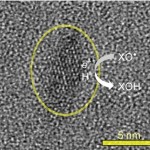June 14, 2012
Science paper explores proton-coupled electron transfer in metal oxide nanoparticles
 A recent publication in Science by Professor James Mayer and coworkers explores the transfer of electrons and protons in titanium and zinc oxide nanoparticles. The chemical reactions that occur on the surfaces of these metal oxides are important for applications such as solar cells. This new research indicates that the usual description of these reactions as electron transfers is incomplete – that the reactions can be more accurately described as proton-coupled electron transfers.
A recent publication in Science by Professor James Mayer and coworkers explores the transfer of electrons and protons in titanium and zinc oxide nanoparticles. The chemical reactions that occur on the surfaces of these metal oxides are important for applications such as solar cells. This new research indicates that the usual description of these reactions as electron transfers is incomplete – that the reactions can be more accurately described as proton-coupled electron transfers.
“As we think about building a better energy future, we have to develop more efficient ways to convert chemical energy into electrical energy and vice versa,” said Prof. Mayer, the Alvin L. and Verla R. Kwiram Endowed Professor of Chemistry.
Chemical reactions that change the oxidation state of molecules on the surface of metal oxides historically have been seen as a transfer solely of electrons. The new research shows that, at least in some reactions, the transfer process includes coupled electrons and protons.
“Research and manufacturing have grown up around models in which electrons moved but not atoms,” Mayer said. The new paper proposes a different model for certain kinds of processes, a perspective that could lead to new avenues of investigation, he said. “In principle this is a path toward more efficient energy utilization.” Coupling the transfer of electrons with the transfer of protons could help reduce the energy barriers to chemical reactions important in many technologies. For example, using solar energy to make fuels such as hydrogen requires that electrons and protons be coupled.
Co-authors of the Science paper are Joel Schrauben, a UW postdoctoral researcher; Rebecca Hayoun, who since has received a doctorate from the UW and is working in the private sector; UW graduate students Carolyn Valdez and Miles Braten; and Lila Fridley, an undergraduate at the Massachusetts Institute of Technology who participated as a summer researcher at UW.
The work was funded by the UW, the American Chemical Society Petroleum Research Fund, the National Science Foundation through the UW-based Center for Enabling New Technologies through Catalysis, and the U.S. Department of Energy.
To learn more about this research, read the UW News press release, the Science article (subscription required), or visit Prof. Mayer’s website and research page.